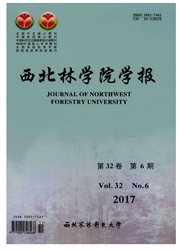

 中文摘要:
中文摘要:
研究了三种不同灌溉周期(3天、14天和不浇水,分别标记为A、B和C)对工业大麻秆理化性能的影响。利用SAS软件分析了灌溉周期对纤维长度、宽度、细胞腔和细胞层数等各物理性能以及三种化学成分(纤维素、半纤维素、木质素)的影响。结果表明灌溉周期对纤维长度和细胞层数的影响显著(p〈0.05),对纤维宽度和细胞腔宽度的影响不显著(p〉O.05),A样品纤维长度最长、形成层的分生频率最高;而对其三种化学成分含量的影响均显著(p〈0.05)。生长天数为120天的工业大麻秆中纤维素含量、半纤维素含量和木质素含量均达到最大值,分别为50.16%、22.63%和20.98%,三大素含量随生长天数的增加而增加;A植株中各化学成分含量最高,C的化学成分最低,而B样品其化学成分含量居中。增加灌溉,有利于提高工业大麻秆中纤维细胞的伸长和各种化学成分的合成,但并不能够改变各化学成分之间的比例。
 英文摘要:
英文摘要:
Raw fiber morphology and chemical composition are the most important factors of biomass materials, which determine the use value of industrial hemp stalk. In order to make better use of industrial hemp stalk biomass materials, three different irrigiation cycles (3days, 14days and only by natural rainfall, respectively marked A, B, C ) which effected physical and chemical properties of industrial hemp stalk were studied. The SAS software was used to analyze the effects of different irrigation cycles of industrial hemp stalk for fiber length, width, lumen and cell layers, ect., as well as three kinds of chemical components (cellulose, hemicellulose and lignin ). Results showed that effects of irrigation for fiber length and cell layers were significant(p〈0.05) for fiber width and cell lumen are relatively insignificant (p 〉0.05). Three contents (cellulose, hemicellulose and lignin) of industrial hemp stalk to grow to 120 days achieve the maximum value, respectively 50.16%, 22.63% and 20.98%, and three major contents increased with the growing number of days. When water was poured once every three days, the chemical composition contents reached the highest. If the stalk only relied on natural rainfall, chemical composition content could reach the lowest. And watered once 14days, chemical composition contents were in the middle. Increasing irrigation frequency, that was beneficial to improve fiber cell length and all sorts of chemical synthesis, but was not able to change the ratio between the different chemical components.
 同期刊论文项目
同期刊论文项目
 同项目期刊论文
同项目期刊论文
 Manufacturing particleboard using hemp shiv and wood particles with low free formaldehyde emission U
Manufacturing particleboard using hemp shiv and wood particles with low free formaldehyde emission U 期刊信息
期刊信息
